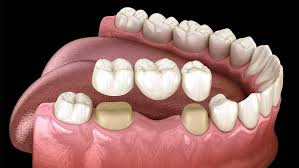A dental crown is a cap that is placed over a tooth to restore its shape, size, strength, and improve its appearance. Crowns are commonly used to protect a weak tooth, restore a broken or severely worn tooth, cover a dental implant, or support a dental bridge.
Here's an overview of the dental crown treatment process:

1. Diagnosis and Treatment Planning:
- Your dentist will examine your tooth, possibly taking X-rays to assess the extent of damage or decay.
- The dentist will discuss treatment options, and if a crown is deemed necessary, a treatment plan will be developed.
2. Tooth Preparation:
- Before placing a crown, the tooth needs to be prepared. This involves removing any decay and shaping the tooth to accommodate the crown.
- In some cases, if the tooth is severely damaged or decayed, the dentist may build up the core of the tooth to provide additional support for the crown.
3. Impressions:
- Once the tooth is prepared, the dentist will take impressions of the tooth. This involves making a mold of the tooth and the surrounding area.
- The impressions serve as a model for creating the custom crown.
4. Temporary Crown:
- While the permanent crown is being fabricated (which may take a couple of weeks), a temporary crown is usually placed to protect the prepared tooth.
- It's important to be cautious with the temporary crown, avoiding sticky or hard foods that could dislodge it.
5. Permanent Crown Placement:
- Once the permanent crown is ready, you will return to the dentist for the final placement.
- The dentist will remove the temporary crown and check the fit and color of the permanent crown.
- Once satisfied with the fit and appearance, the permanent crown is cemented or bonded into place.
6. Post-Treatment Care:
- After the crown is placed, there may be an adjustment period where you need to get used to the new restoration.
- It's essential to maintain good oral hygiene, including regular brushing and flossing, to prevent decay and gum disease.
7. Follow-up:
- Your dentist may schedule a follow-up appointment to ensure the crown is functioning well and there are no issues.
Considerations:
- Crowns can be made of various materials, including porcelain, metal, or a combination of both. The choice of material depends on factors such as the tooth's location, function, and aesthetic considerations.
- Some advancements, like same-day crowns using CAD/CAM technology, may allow for the fabrication and placement of a crown in a single visit.
It's crucial to consult with your dentist to determine the best course of action for your specific dental needs.

No comments yet